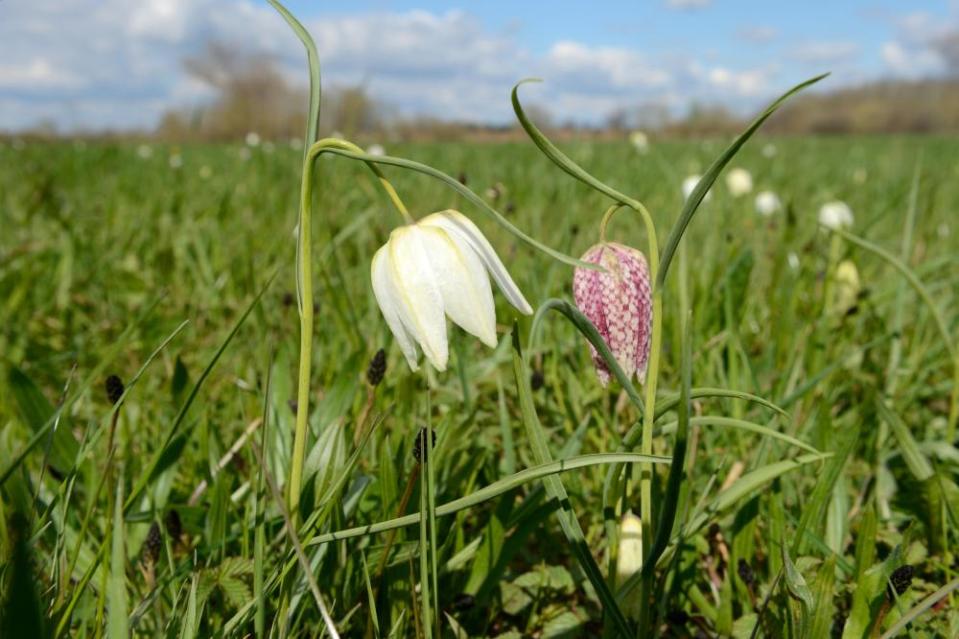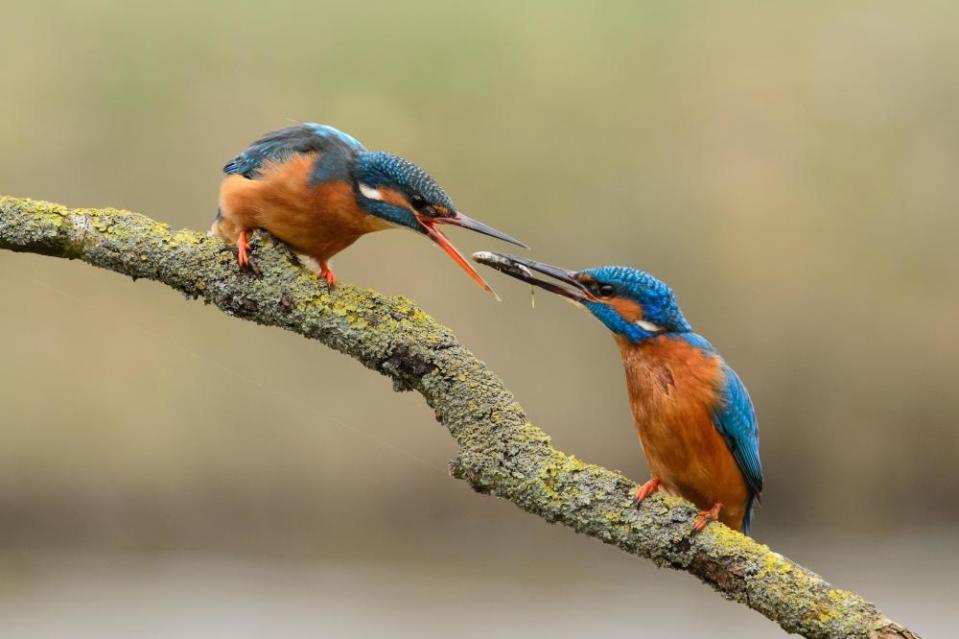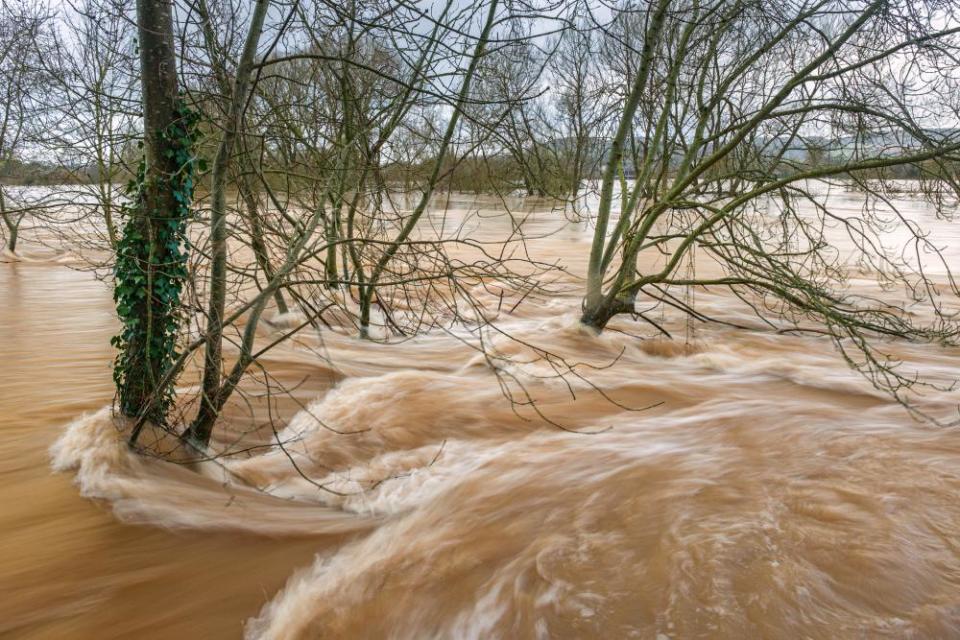'The losses could be profound': how floods are wreaking havoc on wildlife

For 900 years, Lugg and Hampton wildflower meadows in Herefordshire have bloomed into a wash of colour in spring. These fertile meadows were highly prized, and the Norman lords who owned them used the hay crop to help fund Hereford’s cathedrals, churches and castles. The secret to their wonderful bounty was the River Lugg flowing through the middle, fertilising the valley floor with lime and silt each winter it flooded.
But this longstanding system is broken. This winter the valley was submerged under several feet of chocolate-coloured water. It has been flooded almost continuously since October, turning the 120-hectare (297-acre) reserve into an inland lake, with just the tops of gates and fence posts peeping out of the water. Now, as spring approaches, the water is still several inches deep and swans and gulls frolic where mice and rabbits would have burrowed six months earlier.
The damage flooding does to humans has been well-documented, but wildlife populations are unseen casualties, with some ecosystems taking decades to recover. “It is frightening to think that we have only just begun to see what might be ahead with our climate. The losses could be profound,” says James Hitchcock from Herefordshire Wildlife Trust, which manages the Lugg reserve.
“The rate of change we are seeing and the repetition in extreme events is coming too fast for wildlife to adapt … The loss of these meadows could take years and years to reverse and we may never see a return of some species.”

Damage to wetland habitats
Months of flooding is turning Lugg meadows anoxic as oxygen is lost. Worms and other insects suffocate and come to the surface where they are picked off by scavengers such as foxes and crows, reducing the larder of food for rarer species that rely on the reserve in spring. Many delicate grass species like vernal grass and red fescue are likely to be weakened by the floods, leaving a flush of resistant weed species such as thuggish dock leaves and thistles to take their place. In 2012, conservationists resorted to weedkiller to get rid of the dock leaves because the valley had been too wet.
These meadows are highly valuable sites of special scientific interest (SSSIs) and were home to Herefordshire’s only fledged curlew chick last year. Curlews and other ground-nesting birds such as skylarks and reed buntings will have nowhere to nest unless the water subsides in the next week or so. The rare solitary red-shanked carder bee, which nests in mouseholes in tussocky vegetation, could already be wiped out. If flooding becomes too frequent, meticulously managed flood plains like this turn into swamps.
The casualties are far-reaching – otters that live in the Lugg have been killed on roads after being forced into areas where there is less cover. Kingfisher nests normally built into the muddy banks have been submerged under several feet of water. Soil in the water also chokes filter feeders such as dragonfly and damsel larva.
The decline of this rural valley, once rich in meaning and memories, is part of what Hitchcock calls the “homogenisation of the countryside”. All over the country, generalist species like rooks, crows and gulls thrive at the expense of specialised species that are picky about their habitat. Only around 1,200 hectares of species-rich flood plain meadows remain in the whole of the UK, with most of them lost due to the intensification of agriculture. Many of these rare species have nowhere to migrate to if their habitat is destroyed.
“This flooding is one element in a general narrative of decline. When flooding is this prolonged, insects and vertebrates start to die and that includes things like earthworms. It then takes years to recover. In that intervening period you have less food for birds and potentially the loss of some species. Everything is getting hit from every angle,” says Hitchcock.

Farther down the Lugg at Bodenham Lake, prolonged flooding may have drowned 1,500 young reeds, planted in 2019 as part of a £520,000 project managed by the Herefordshire Wildlife Trust to create more habitats for declining wetland species such as warblers and bearded tits.
Sophie Cowling, senior project officer at Lugg Living Landscape, says: “The lake’s water levels have been extremely high since the end of October, due to repeated flooding. The floodwaters have fully submerged the young reed plants; if they drown it will be costly to replace them and the conservation of declining wildlife that relies on reedbeds will be delayed by several years.”
Damage to river ecosystems
Thirty miles south-west is the village of Llanwenarth in the Abergavenny district in Monmouthshire, Wales. Two 16th-century manor houses and a church perched on land raised from the flood plain are a nod to former rural communities that once thrived in these valleys. The 16th-century houses had never flooded until earlier this year when they had three feet of water running through. The damage to the valley exceeded the three previous large floods in 1853, 1947 and 1979.
Fortunately these floods were not at a time when fish were spawning but their regularity worries Simon Evans, chief executive of the Wye and Usk Foundation. “In the Usk we’ve had record floods in 2018, 2019 and now in 2020. That’s three massive floods in the last 20 months. Imagine each one as a bang on the ecology – if you keep hitting it it just goes away. Rivers just cannot survive flood after flood after flood.”
Fast-moving water causes gravel at the bottom of rivers – which is key for river ecosystems – to be ripped away and spat out farther downstream. Macroinvertebrates such as bull head, stone larch and marsh brown lose their homes, says Evans. “These animals are the life-support systems in the river. They provide food for the dippers and the fish, which provide food for the kingfisher, so if you don’t have the macroinvertebrates because you have taken away their houses then your whole ecology is done.”

On a tributary of the Llynfi, only the red bedrock is visible and the gravel patches where salmon and trout previously spawned have washed away. A single flood can impact populations for decades to come; the 1977 flood at Selkirk in the Scottish Borders washed away salmon eggs that had just been laid in the gravel and the effects were apparent on spring salmon catches in the River Tweed 25 years later, according to Evans.
In September 2012 more than 200,000 tonnes of soil left the Lugg in one flood, the equivalent of 26 hectares of top soil. There is up to 150mg of soil per litre of water in many of these rivers, and roads are visibly stained red after the water has subsided. This is caused by water flooding agricultural land – much of which is bare after being harvested for maize or root vegetables – and washing valuable topsoil into rivers. This soil is often doused in pesticides and fertilisers which cause additional damage to river ecosystems.
“Our rivers are not adapted to these elevated sediment loads, and our ecology is not adapted to elevated sediment loads. We should not see big brown rivers sliding past but what we see is big brown rivers sliding past and that’s because of how we manage our land. We’ve got this shifting baselines thing going on – people think the Lugg has always been brown but it hasn’t,” says Evans.
Eggs in the gravel rely on flowing water to bring them oxygen and remove waste, but soil blocks up these holes and reduces the amount of water reaching the eggs, meaning they can suffocate and die. It also reduces visibility so river creatures cannot hunt so easily.

Divided communities
Historically these traditional farming communities would have been centres for human trade, migration and settlement, but the battle to control water is dividing communities. Tristan Pearson, an ecologist and trustee of the Badger Trust, grew up in the Welsh borders where the Severn and Vyrnwy rivers meet. He monitors badger setts near Pentre, Shrewsbury, which sits close to the border between England and Wales. Here, the roads have turned into rivers intersected with islands of tarmac. Some areas have been underwater for more than three and a half months.
For badgers, late winter storms come at the worst time because cubs are in underground dens and will drown unless the sow can get them out (which she does by picking them up in her mouth one by one). Pearson feels increasingly concerned about the future of these valleys for both the wildlife and people that live here. His parents were farmers and Pearson kept livestock himself but two years ago turned vegan due to concerns about the environmental impacts of livestock farming.
“Climate change is the big thing. We can’t keep ignoring it. You look up at the overgrazed hillside from six feet of water and everything you can see is being propped up by government money. It’s not sustainable. This prolonged flooding is starting to turn into an annual event – it was once in a lifetime, then once every decade and now it’s all the time.”
Samantha Somers, environment manager at Natural England, says the organisation will continue to support natural flood management measures, including creating space for temporary ponds and restoring rivers.
“Recent flooding unfortunately caused significant distress and disruption for communities and businesses. However as flooding is a natural process, flood plains can generally continue to support ecosystems which are rich in wildlife and can accommodate floodwaters when rivers burst their banks,” she says.
Find more age of extinction coverage here, and follow biodiversity reporters Phoebe Weston and Patrick Greenfield on Twitter for all the latest news and features

 Yahoo News
Yahoo News 
